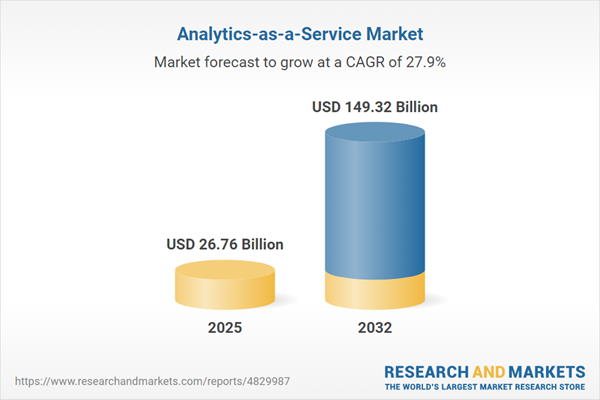Speak directly to the analyst to clarify any post sales queries you may have.
Analytics-as-a-Service empowers organizations to harness their data more effectively, improving compliance and operational performance amid rapidly shifting regulatory and business environments. This model provides senior leaders with agile analytical tools that streamline workflows and drive informed innovation across diverse enterprise operations.
Market Snapshot: Analytics-as-a-Service Market Growth
The Analytics-as-a-Service market is seeing rapid expansion, fueled by widespread digital transformation efforts in both traditional and emerging sectors. Demand for intelligent automation and increasing regulatory requirements are guiding organizations to adopt cloud-driven analytics solutions. In 2024, the market reached USD 20.82 billion and is on track to achieve USD 26.76 billion by 2025, with a strong outlook toward USD 149.32 billion by 2032. This represents a compound annual growth rate of 27.92%. Enterprise priorities now center on artificial intelligence-driven analytics, simplifying internal operations, and staying prepared for compliance changes. These dynamics are promoting stronger market positioning for organizations targeting global and regional opportunities.
Scope & Segmentation of the Analytics-as-a-Service Market
This report delivers a comprehensive analysis of Analytics-as-a-Service, tailored for business leaders seeking to optimize technology investment and operational strategy. The market is segmented by several practical criteria, enabling targeted approaches to complex business needs:
- Industry Verticals: Solutions are leveraged by finance, energy, government, defense, healthcare, IT, telecommunications, manufacturing, broadcasting, gaming, publishing, and transportation sectors, where analytics drive tangible compliance, process, and efficiency improvements.
- Deployment Modes: Organizations select from hybrid, private, and public cloud deployments to address requirements for data privacy, scalability, and sustained business growth.
- Organization Size: Both large and small-to-medium-sized enterprises adopt analytics tools for improved resource management, business continuity, and risk mitigation efforts.
- Analytics Types: Descriptive, diagnostic, predictive, and prescriptive analytics platforms equip teams to solve complex challenges and identify new growth opportunities.
- Pricing Models: Pay-per-use and subscription models offer adaptability to organizational budget structures and evolving compliance demands.
- End Users: Analytics is deployed across finance, HR, IT, marketing, and operations to streamline operations and enhance cross-functional collaboration.
- Data Types: Both structured and unstructured data are utilized to meet robust compliance and governance requirements, especially in sectors subject to heightened oversight.
- Geographies: Coverage spans the Americas, EMEA, and Asia-Pacific, with insights into adoption trends, local competition, and regulations especially in the United States, China, Germany, and Japan.
- Companies Profiled: Solutions and platforms from Google LLC, Microsoft Corporation, Amazon Web Services, IBM, Oracle, SAP SE, SAS Institute Inc., Salesforce Inc., TIBCO Software Inc., and QlikTech International AB illustrate the market's breadth and competitive diversity.
Key Takeaways for Senior Decision-Makers
- Cloud-native analytics offerings streamline compliance activities, strengthening adaptability as organizations manage complex regulatory shifts and diverse industry demands.
- Integrated analytics platforms improve operational governance in hybrid and multi-cloud settings, maintaining visibility and control for executive teams across all divisions.
- Industry-specific analytics solutions support core compliance objectives and drive efficiency in specialized sectors like finance, healthcare, and manufacturing.
- Flexible deployment options and pricing structures enable organizations to strategically adjust analytics investments in response to market and compliance developments.
- Real-time analytic capabilities facilitate collaborative decision-making, ensuring business units can respond rapidly to operational or compliance challenges.
Tariff Impact: Navigating Cost Factors and Regional Strategies
Forthcoming changes to United States tariff policies are expected to influence hardware-related costs for Analytics-as-a-Service projects. Organizations are increasingly adopting distributed data center infrastructure and emphasizing software-driven approaches to sustain reliable service delivery and contain costs. Adjusting platform deployments to local regulation is now a vital element of global analytics planning.
Methodology & Data Sources
The findings in this report are based on rigorous expert interviews, verified supplier data, user surveys, and transaction analysis. Review by industry specialists ensures that the insights provided are both relevant and directly applicable for C-level executives considering analytics investments.
Why This Report Matters
- Supports risk-conscious decision-making and guides implementation of scalable analytics in line with emerging business requirements.
- Delivers actionable assessments of technology and regional compliance trends, enhancing the impact of enterprise-wide analytics strategies.
- Informs prioritization of analytics investment for efficiency and measurable improvement, providing a foundation for sustained operational advancement.
Conclusion
Analytics-as-a-Service equips organizations to respond effectively to regulatory shifts and industry developments, empowering leadership teams to achieve strategic data-driven growth and enhanced business resilience.
Additional Product Information:
- Purchase of this report includes 1 year online access with quarterly updates.
- This report can be updated on request. Please contact our Customer Experience team using the Ask a Question widget on our website.
Table of Contents
3. Executive Summary
4. Market Overview
7. Cumulative Impact of Artificial Intelligence 2025
Companies Mentioned
The companies profiled in this Analytics-as-a-Service market report include:- Google LLC
- Microsoft Corporation
- Amazon Web Services, Inc.
- International Business Machines Corporation
- Oracle Corporation
- SAP SE
- SAS Institute Inc.
- Salesforce, Inc.
- TIBCO Software Inc.
- QlikTech International AB
Table Information
| Report Attribute | Details |
|---|---|
| No. of Pages | 181 |
| Published | October 2025 |
| Forecast Period | 2025 - 2032 |
| Estimated Market Value ( USD | $ 26.76 Billion |
| Forecasted Market Value ( USD | $ 149.32 Billion |
| Compound Annual Growth Rate | 27.9% |
| Regions Covered | Global |
| No. of Companies Mentioned | 11 |









